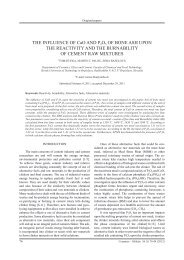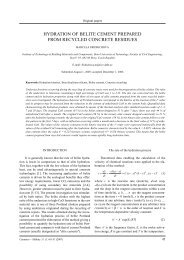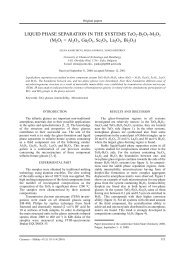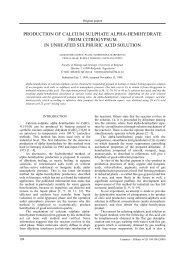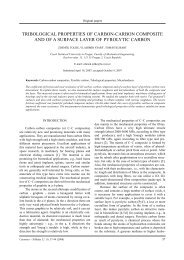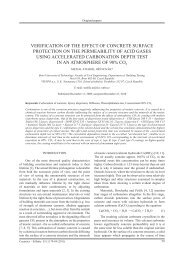PROPERTIES OF Eu3+ LUMINESCENCE IN ... - Ceramics-Silikaty
PROPERTIES OF Eu3+ LUMINESCENCE IN ... - Ceramics-Silikaty
PROPERTIES OF Eu3+ LUMINESCENCE IN ... - Ceramics-Silikaty
Create successful ePaper yourself
Turn your PDF publications into a flip-book with our unique Google optimized e-Paper software.
completely. The appropriate molar ratio of Ba(NO 3) 2,<br />
Mg(NO 3) 2·6H 2O, Eu(NO 3) 3, NH 2CONH 2 and H 3BO 3<br />
were dissolved in a minimum amount of distilled water<br />
to get a clear solution. Then a stoichiometric amount of<br />
Si(OC 2H 5) 4 dissolved in ethanol was added dropwise<br />
into the above solution under vigorous stirring. Si(OH) 4<br />
was formed by the hydrolysis of Si(OC 2H 5) 4 as follows:<br />
nSi(OC 2H 5) 4 + H 2O → nSi(OH) 4 + 4nC 2H 5OH<br />
The mixture solution was allowed to react at 80°C<br />
for 2 h to obtain a homogenous solution. and then the<br />
solution was introduced into a muffle furnace preheated<br />
at 600°C. within a few minutes, the solution boiled and<br />
was ignited to produce a self-propagating flame. The<br />
product obtained was post-annealed at 1000°C for 3 h.<br />
Sample characterization<br />
The synthesized phosphors were ground to powder<br />
and sieved by 200 mesh for characterization. The crystal<br />
phase of the synthesized powders prepared in the process<br />
was characterized by X-ray powder diffraction using<br />
an X′ Pert PRO X-ray diffractometer having a Cu Kα<br />
radiation (λ = 1.5406 Å) at 40 kV tube voltage and 40 mA<br />
tube current. The XRD patterns collected in the range of<br />
10° ≤ 2θ ≤ 90°. The excitation and emission spectra were<br />
performed on a RF-5301 fluorescence spectrophotometer<br />
equipped with a xenon discharge lamp as an excitation<br />
source. The excitation and emission slits were set<br />
to 3.0 nm. all the above measurements were taken at<br />
room temperature.<br />
The chromaticity coordinates were obtained according<br />
to the Commission International de l'Eclairage<br />
(CIE) using a Spectra Lux Software v.2.0 Beta [14, 15].<br />
RESULTS aND DISCUSSION<br />
Crystal structure<br />
The crystal structure of Ba 2MgSi 2O 7 is composed<br />
of a tetrahedron framework, [Mg 2Si 2O 7], and isolated<br />
barium atoms. Two silicon tetrahedral are connected by<br />
sharing an oxygen, forming a di-silicate group Si 2O 7[16].<br />
all of the barium atoms are located in the channel and<br />
coordinated by oxygen atoms in both the structures<br />
(Figure 1).<br />
Phase formation<br />
The stoichiometric composition of the redox<br />
mixture was calculated based on the total oxidizing<br />
and reducing valence of the oxidizer and the fuel. For<br />
the combustion synthesis of oxides, metal nitrates are<br />
employed as oxidizer and urea is employed as a reducer<br />
[17]. with the calculation of oxidizer to fuel ratio, the<br />
Yao S., Xue L., Yan Y.<br />
elements were assigned formal valences as follows:<br />
Ba = +2, Mg = +2, Eu = +3, Si = +4, B = +3, C = +4,<br />
H = +1, O = -2 and N = 0. accordingly, the oxidizer and<br />
fuel values for various reactants are as given below:<br />
For complete combustion, the oxidizer and the fuel<br />
serve as a numerical coefficient for the stoichiometric<br />
balance, so that the equivalence ratio is equal to unity (total<br />
oxidizing valency / total reducing valency (O/F) = 1), and<br />
the maximum energy is released [18]. Thus, the molar<br />
ratio of the reactants taken is 1.95:1:0.05:2:0.06:5 for Ba<br />
(NO 3) 2:Mg(NO 3) 2:Eu(NO 3) 3:Si(OH) 4:H 3BO 3:CO(NH 2) 2.<br />
Owing to the combustion process, the solution boiled<br />
and dehydrated, followed by decomposition with escape<br />
of large amounts of gases (oxides of carbon, nitrogen<br />
and ammonia), then spontaneous ignition occurred<br />
and underwent smoldering combustion with enormous<br />
swelling. The whole combustion process was over within<br />
less than 5 min. after the combustion, the ashes were<br />
cooled to room temperature. Finally, the ashes obtained<br />
were post-annealed at 1000°C for 3 h.<br />
The XRD patterns of our samples, Ba 2-xMgSi 2O 7:<br />
Eu x 3+ (x = 0-0.09), are shown in Figure 2, which indicated<br />
that doped Eu 3+ ions have no obvious influence on the<br />
structure of the host. a pure phase of the monoclinic<br />
Ba 2MgSi 2O 7 has formed in these samples. The fraction<br />
peak positions and the relative intensities of the prepared<br />
samples are well matched with that in the literature. The<br />
layered structure, with the following cell parameters:<br />
a = 8.4128 Å, b = 10.7101 Å, c = 8.4387 Å, β = 110.71°,<br />
consists of discrete [Si 2O 7] 6- units connected by tetrahedral<br />
coordinated Mg 2+ and eight-coordinated Ba 2+<br />
ions [16]. No trace of the previously reported tetragonal<br />
Ba 2MgSi 2O 7 phase could be observed in the XRD<br />
patterns [19]. In this work, the structure of monoclinic<br />
Ba 2MgSi 2O 7 with space group C2/c was taken as the<br />
starting model for the synthesized phosphors.<br />
Figure 1. Crystal structure of Ba 2MgSi 2O 7.<br />
252 <strong>Ceramics</strong> – Silikáty 55 (3) 251-255 (2011)



